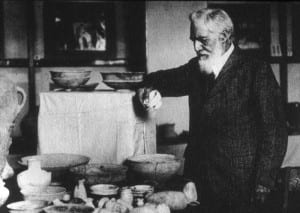Museum storerooms are by their very nature elusive creatures; the demands of finding space for the sixty-plus thousand objects in the Institute of Archaeology collections means that objects often lie cheek to jowl with one another fighting for both room and attention. For the curator, exploring a busy storeroom means that every now and again you will encounter the unfamiliar, the exciting, and sometimes the downright bizarre. Like this recently rediscovered object, known officially as 46.10/22.
I first met 46.10/22 in an overcrowded drawer, mixed in with pottery from former excavations at the site of Jericho, from the modern-day Palestinian Autonomous Authority. Jericho itself is the stuff of legend – notorious for its trumpet-sensitive walls in the Book of Joshua (Joshua 5 – 6), from which account we derive the desire to ‘wish someone to Jericho’. But it has taken on other resonances in modern culture: as a tourist destination, the theme of a song by legendary 70s band Stray, or reinvented for television as a spy thriller and now an American town at the centre of a post-apocalyptic drama. Its also been the home of a few archaeological ‘discussions’, including a rather entertaining debate in 1990 between Manchester Museum’s Piotr Bienkowski and biblical archaeologist Bryant G. Wood (“Jericho was Destroyed in the Middle Bronze Age, not the Late Bronze Age”, Biblical Archaeology Review 16.5, 45-6, and “Dating Jericho’s Destruction: Bienkowski is Wrong on all Counts”, Biblical Archaeology Review 16.5, 45-9). (more…)
 Close
Close



